Key trends in K12 robotics education
Robotics education is becoming increasingly commonplace in schools. This is largely due to the fact that students in K12 schools will graduate into a workforce that’s rife with technology, in an era where robots will become widely used in our everyday lives.
Even if these kids choose a career other than coding or robotics, learning robotics teaches them many important skills such as analytical thinking, programming, teamwork, collaborative thinking, innovation and more. It can be easily incorporated into STEAM education, which is becoming more popular in schools worldwide.

- 0 Comments
- Oct 10, 2019 10:00:50 AM
Feature a Teacher: Using NAO as a tool for learning and as an adventure program simulator.
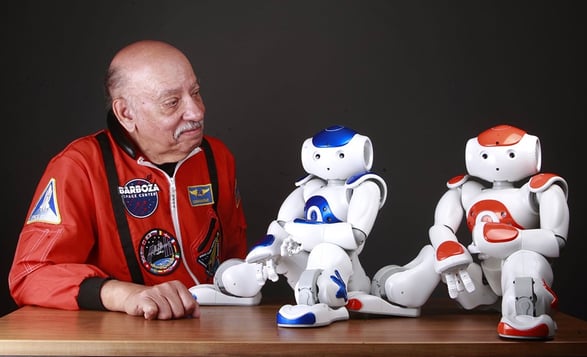
Bob Barboza is an educator, STEM journalists, composer and founder of the Barboza Space Center STEM & STEAM fellowship Program and Kids Talk Radio Science. http://www.barbozaspacecenter.com/ He trains Jr. astronauts, engineers, and scientists for the "Occupy Mars Learning Adventures." His students and interns are learning robot and satellite design, building, and repair.
- 0 Comments
- Apr 25, 2018 4:03:04 PM
- Posted by Maria Alejandra Calcetero
- Topics: Education, NAO, Robots,
Feature a Teacher: NAO as an emotional robot for students
Mauro Colucci a Mechatronics teacher, and Maila Biaggi a English language teacher at Vocational School’G. Marcelli’- http://www.scuolafoiano.gov.it/ they have been using the NAO Robot for two years when the school was looking for an emotional robot completely programmable that could have a strong impact on the students. they met NAO Robot and since then, they realized it was the perfect tool for them.
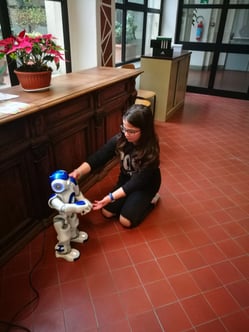
- 0 Comments
- Apr 25, 2018 3:56:43 PM
- Posted by Maria Alejandra Calcetero
- Topics: Education, NAO, Curriculum, Interaction
Feature a Teacher: NAO as a tool for fun and engaging project based-learning activities.
Tobe Roberts is an Educational Technologist at Bergen County Technical Schools, he has been using the NAO Robot to introduce a lesson, deliver exit ticket questions, create simulations with role play for the students utilizing the robot. Mr. Roberts created Pony Express simulation, Star Trek StarFleet Academy simulation for the topic of forms of Energy and NASA Space Flight simulation.
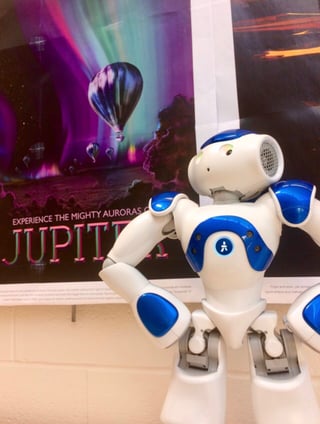
- 0 Comments
- Apr 25, 2018 3:54:42 PM
- Posted by Maria Alejandra Calcetero
- Topics: Education, NAO, Curriculum
Feature a Teacher: Using NAO in Behavior Analysis
Thus far, NAO and other humanoid robots are commonly used successfully to help teach children STEM subjects, as well as help children with autism learn social skills. But there is one education program using NAO in a completely different way - and with some very promising results.
Dr. Ellie Kazemi is a behavior analyst who is using NAO in a very unique way. She is currently a Professor of Psychology and the Academic Director of the Masters of Science in Applied Behavior Analysis Program at California State University, Northridge (CSUN.) For her research, she and her students are using NAO to simulate a child with problem behavior in order to find helpful strategies in training caregivers (staff, teachers, etc.) how to deal with problem behavior.
Dr. Kazemi has been able to secure some research and training funds to purchase three NAOs, warranties, and licenses to engage research assistants in science and technology. The funds were provided through the College of Social and Behavioral Sciences and the National Institute of Health-Build Poder.
Programming NAO to display undesirable behavior (i.e., to be “bad”) and then running simulations helps the students learn in hands-on labs. The team has the robot throw tantrums, hit himself, and more - even programming in variations so he looks and acts a little different in each simulation. This gives them a lot of control in the types of behavior the person they are training gets to see.
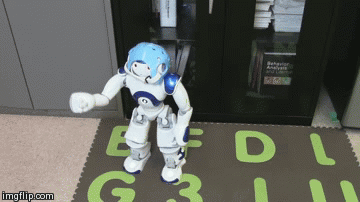
- 0 Comments
- Apr 25, 2018 3:44:16 PM
- Posted by Chrissy Hoff Hudson
- Topics: Education, NAO, teachers, College
Big announcements for the Educational Market during Apple's event in Chicago

March 27, 2018- Chicago, USA
During Apple's Educational event, Apple CEO Tim Cook introduced different technologies for the educational market highlighting and reaffirming their constantly work on this field.
- 0 Comments
- Mar 28, 2018 3:21:36 PM
- Posted by Maria Alejandra Calcetero
- Topics: Education, Curriculum, Technology, Innovation
Are we doing enough to increase participation in STEM fields?
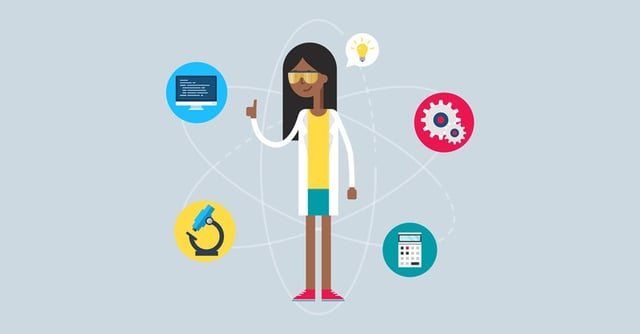
This words are from professor Gijsbert Stoet: “If governments want to increase women’s participation in STEM, a more effectively strategy might be to target the girls who are clearly being ‘lost’ from the STEM pathway: those for whom science and math are their best subjects and who enjoy it but still don’t choose it.” http://bit.ly/2EHezl3
And they really got us thinking if we are doing enough for gender equality related to STEM fields and if we are responsibles for keep inspiring young people and specially women to choose this type of careers, so we want to hear your thoughts!
Whether you are a teacher, a parent, or anyone who wants their voice to be heard, we have a survey for you! please submit your answers
Teachers: https://www.surveymonkey.com/r/Q2LZ68C
Parents: https://www.surveymonkey.com/r/WPZGD85
Anyone: https://www.surveymonkey.com/r/SVKPJDJ
- 0 Comments
- Feb 23, 2018 4:07:30 PM
- Posted by Maria Alejandra Calcetero
- Topics: Education, Curriculum
Robotic Arm TEKS Education Standards 2017-2018
For the first time, TEKS include product specific standards for robotics arm, highlighting the importance for the students to take part in and understand Industry 4.0 is the current trend of automation and data exchange in manufacturing technologies that will shape their future. It provide hands-on Computer Science for students and brings coding to life.
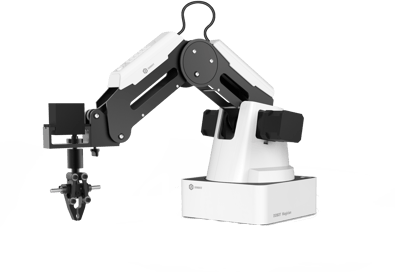
Dobot Magician integrates programming, mechanics, electronics, and automation. It’s a great STEAM teaching device that strengthens knowledge across multiple subjects, through a high precision and user-friendly UI. It also provides, enjoyable functions, and unlimited developing possibilities. Dobot Magician’s captivating and exploratory experience increases interest in science and technology.
- 0 Comments
- Feb 20, 2018 3:52:31 PM
- Posted by Maria Alejandra Calcetero
- Topics: Robotics, Education, Curriculum, Learning, Standards
Breaking the habit of too much screen in school by using physical devices
There is no shortage of articles and think-pieces on the evils of “screen-time”.Everyone from the National Public Radio to Psychology Today are bemoaning the negative impact of our dependence on screen-based entertainment and utilities. Here at RobotLAB, we don’t dispute the research.

- 0 Comments
- Dec 15, 2017 6:52:12 PM
- Posted by Samantha Baker
- Topics: Robotics, EdTech, Education, Coding, Robots,, programming, Technology, Learning, Digital tools
Do we really need to teach Algebra?
One of the most debatable topics these days is whether we should keep teaching high school math or not.
“Where will I use it in my life” is common feedback from the grouchy students. However, studies show that students don't mind practicing math, its testing math where we lose them.
And we lose them badly. In 2016 a Paris-based Organization for Economic Cooperation and Development (OECD) unveiled the results of an international math quiz that showed U.S. high school students lag behind their global peers in math, ranking 40th in math out of 72 countries last year. The U.S. score was down 17 points from 2009 and 20 points below the average of others taking the quiz, which saw Singapore come out on top, followed by Japan, Estonia, Finland, and Canada.
As a result of this failure, many in and out of the school system advocate to “lower the bar”, drop Pre-Calc, Algebra II or even Algebra I from the curriculum (and standardized testing) and help students overcome the “math anxiety” by bypassing the subject altogether.

- 0 Comments
- Jul 6, 2017 4:26:03 PM
- Posted by Anna Sandler
- Topics: Math, Education, algebra,, students
Relevant Posts
Popular Posts
Subscribe to Email Updates
-
I Want To Learn MoreADDITIONAL INFORMATION


